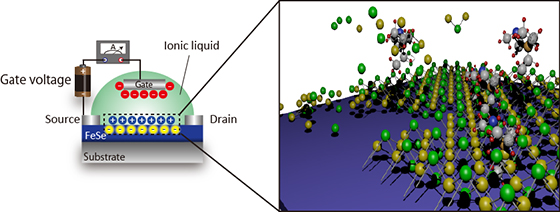Electrochemical etching down to one-monolayer towards high-Tc superconductivity

Figure: Schematic of electric-double-layer transistor device and electrochemical reaction on FeSe surface. (Left) Device structure of electric-double-layer transistor with FeSe channel deposited on oxide substrate. (Right) One-monolayer FeSe is realized by electrochemical etching where Fe and Se ions are dissolved into ionic liquid. Copyright : Tohoku University
Iron selenide (FeSe) is an attracting superconducting material since the superconducting transition temperature (Tc) is enhanced from 8 K in bulk form toward 65 K in one-monolayer form.
However, systematic thickness dependence of electrical measurement has been difficult to address.
A team of researchers at Tohoku University's Institute for Materials Research (IMR), has realized layer-by-layer etching in superconducting FeSe films down to approximately one-monolayer about 0.6 nm using classical electrochemical reaction in electric-double-layer transistor configuration.
As the thickness of the films becomes thin, the superconducting transition temperature (Tc) is increased from bulk value (8 K) to about 40 K.
In addition, the research group unveils that by combining with an electrostatic charging effect, the high-Tc transition can be induced in 10-nm thick condition (20 monolayers), which had been limited in one/two-monolayers so far.
The development of this etching technique will pave the way for the exploration of nontrivial physical phenomena in atomically thin two-dimensional films. This had previously been difficult to address by conventional methods.
This work was published in Nature Physics online on Nov 2, 2015.
Publication Information
Authors: J. Shiogai, Y. Ito, T. Mitsuhashi, T. Nojima and A. Tsukazaki
Title: Electric-field-induced superconductivity in electrochemically etched ultrathin FeSe films on SrTiO3 and MgO
Journal: Nature Physics
DOI: 10.1038/nphys3530
Contact:
Junichi Shiogai
Institute of Materials Research, Tohoku University
Email: junichi.shiogaiimr.tohoku.ac.jp
Atsushi Tsukazaki
Institute of Materials Research, Tohoku University
Email: tsukazakiimr.tohoku.ac.jp
Associated links
Original article from Tohoku Unviersity
Media Contact
More Information:
http://www.researchsea.comAll latest news from the category: Materials Sciences
Materials management deals with the research, development, manufacturing and processing of raw and industrial materials. Key aspects here are biological and medical issues, which play an increasingly important role in this field.
innovations-report offers in-depth articles related to the development and application of materials and the structure and properties of new materials.
Newest articles

Innovative vortex beam technology
…unleashes ultra-secure, high-capacity data transmission. Scientists have developed a breakthrough optical technology that could dramatically enhance the capacity and security of data transmission (Fig. 1). By utilizing a new type…

Tiny dancers: Scientists synchronise bacterial motion
Researchers at TU Delft have discovered that E. coli bacteria can synchronise their movements, creating order in seemingly random biological systems. By trapping individual bacteria in micro-engineered circular cavities and…

Primary investigation on ram-rotor detonation engine
Detonation is a supersonic combustion wave, characterized by a shock wave driven by the energy release from closely coupled chemical reactions. It is a typical form of pressure gain combustion,…



